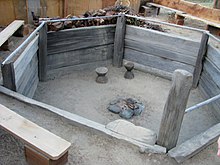tse:ning-xwe | |
|---|---|
 łe:lding xontah - mouth of the South Fork of the Trinity River, principal Tsnungwe village | |
| Total population | |
| 150-200 | |
| Regions with significant populations | |
| California (Salyer ) | |
| Languages | |
| Hupa, Chimariko |
The Tsnungwe (current Hupa-language orthography, own name: Tse:ningxwe - "Tse:ning-din (Ironside Mountain) People") or Tsanunghwa are a Native American people indigenous to the modern areas of the lower South Fork Trinity River (yisinch'ing-qeh), Willow Creek (xoxol-ding), Salyer (miy-me'), Burnt Ranch (tse:n-ding/tse:ning-ding) and New River (Yiduq-nilin) along the Trinity River (hun' 'river') in Trinity and Humboldt County in California.[1] The Tsnungwe were a bilingual Hupa-Chimariko-speaking people and are known by the Hupa-speaking peoples as tse:ning-xwe.[2] The primary language was the Tsnungwe dialect of Hupa, and the secondary language was Chimariko, although spoken with a Hupa accent.[3]
The Tsnungwe include two sub-groups called łe:lxwe ('People of łe:l-ding') after their most important settlement and religious center, and the Chima:lxwe'/Chimalakwe/Tł'oh-mitah-xwe ('grass, prairies-amongst-people') along New River. The Karuk living north of the Salmon River Divide called the Chima:lxwe'/Chimalakwe/Tł'oh-mitah-xwe Akráak va'ára ('New River People').[4] The Norelmuk Wintu from Hayfork called the Tsnungwe Num-nor-muk.[5]
Because their language is a dialect of the Hupa language, they are also called South Fork Hupa. Other tribal names refer to their territories occupied: South Fork Indians, Burnt Ranch, South Fork Trinity Tribe, and Kelta/Tlelwe/Hlelwe/Tlelding/Leldin Tribe or Tlohomtahhoi, Chaltasom.[6]
Neighboring tribes to the Tsnungwe include the Yurok, Redwood Creek Hupa, Hoopa Valley Hupa, Wiyot, Chimariko, Shasta, Karuk, and Wintu. Often times, Tsnungwe spoke many Native languages.[7] C. Hart Merriam referred to Tsnungwe leader Saxey Kidd as "a well-known polyglot," speaker of many languages.
- ^ Rowley, Max; Wooden, Margaret. "Big River: A Look at the South Fork of the Trinity by Max Rowley and Margaret Wooden". Humboldt Historian. 50 (1, Spring 2002): 15–23.
- ^ "Chesbo family, Burnt Ranch. August 1921 1". oac.cdlib.org. Retrieved December 24, 2020.
- ^ Hupa Language Dictionary - 2nd Edition, pages iii and 100
- ^ Ararahih'urípih - Karuk Dictionary
- ^ Ethnogeographic and Ethnosynosymic Data from Northern California Tribes, by C. Hart Merriam, pages 111-112, Edited by Robert Heizer, Archaeological Research Facility, Department of Anthropology, University of California, Berkeley, 1976
- ^ Tsnungwe Place Names, by Tsnungwe Tribal Elders, 1994
- ^ Map by C. Hart Merriam, Bureau of American Ethnology